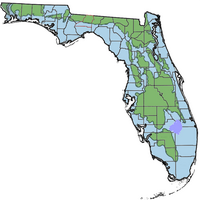Suwannee County, Florida paleontological sites
Appearance


The Suwannee County, Florida paleontological sites are assemblages of Early Miocene invertebrates and vertebrates occurring in Suwannee County, Florida.
Age
[edit]Era: Neogene
Period: Early Miocene
Faunal stage: Arikareean (30.8—20.6 Ma.), calculates to a period of approximately 1.2 million years.
Sites
[edit]S1BA site aka Live Oak site. AEO: ~21.8—21.7 Mya., approximately 0.1 million years[1]
Coordinates: 30°18′N 83°00′W / 30.3°N 83.0°W
Specimens
[edit]Mammals
[edit]- Anchitheriinae (horse)
- Arikarictis chapini (mustelid)
- Daphoenodon (bear-dog)
- Leptocyon (canine)
- Eomyidae (gopher)
- Geomyoidea (pocket gopher)
- Herpetotherium (pygmy opossum)
- Harrymys magnus
- Mammacyon obtusidens (bear-dog)
- Megalictis frazieri (mustelid)
- Nothokemas waldropi (camel)
- Palaeogale minuta (catlike carnivore)
- Phlaocyon leucosteus
- Protosciurus (tree squirrel)
- Vespertilionidae (bat)
References
[edit]- ^ Alroy, John AEO estimate.
- Paleobiology Database, Collection 17837, authorized by John Alroy, Ph.D., National Center for Ecological Analysis and Synthesis, University of California, Santa Barbara
- Alroy, J., Conjunction among taxonomic distributions and the Miocene mammalian biochronology of the Great Plains. Paleobiology 18(3):326-343, 1992.
- Alroy, J., 2008. Speciation and extinction in the fossil record of North American mammals. Ecological Reviews, 2008.
- Hayes, F. G., The Brooksville 2 local fauna (Arikareean, latest Oligocene) Hernando County, Florida. Bulletin of the Florida Museum of Natural History 43(1):1-47. 2000.
